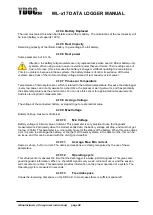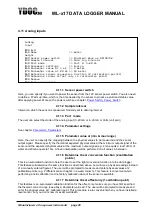
ML-x17 DATA LOGGER MANUAL
Manufacturers of low power instruments
page 24
This interval determines when a data value, obtained by the sample interval-task, is stored onto the SD-
card. This type of interval is ALWAYS valid. So, even when the data logger is in sleep-mode, it will wake
up when the Data logging Interval has reached its count.
4.1.1.3
Send Interval
The send interval determines the interval on which data is send, via the internal modem. This interval is
ALWAYS valid, even if the data logger is in sleep-mode.
4.1.1.4
Example
Let’s evaluate the following settings of the data logger:
-
Sample Interval: 5 seconds
-
Data Log Interval: 10 minutes
-
Send Interval: 3 hours
When the configuration is ready, and the user disconnects the USB-Cable;
1. Data logger is switched into sleep-mode, and current draw is reduced to a minimum level.
2. The Sample interval of 5 seconds is discarded (except for special alarming modes), because this
interval is only active when the data logger is NOT in sleep-mode. So, nothing happens until the Data
Log interval has reached his count. (So, this happens on 0, 10, 20, 30, 40, 50 minutes every hour)
3. When the Data Log Interval count has reached his count, the data logger will awake from the sleep
mode, and will take a sample and stores the data on the SD-card. When the sample is taken, the data
logger goes into sleep-mode again. This is repeated, until the time has matched the Send interval. So,
in this example, this is 3 hours.
4. When Data Send interval is reached, the data logger will wake-up, and starts to send the previously
collected data (stored on the SD-card) to the server. So, in this example, every 10 minutes a sample is
taken, and every 3 hours, 18 samples are send.
Note:
So, the data logger does not perform any averaging. Even if the sample interval is much faster than
the data log interval, only one sample is stored.
The use of the sample interval is for evaluating proper behaviour of the system, while the USB is
connected, and for special alarming modes. Because in that case, the sample interval is valid, and the
user can observe the value’s obtained from the sensor in real time. In this case, the user can evaluate
these values every 5 seconds.
4.1.2 Common data output settings
Data can be transferred by various internet protocols a/o FTP & MQTT of which the specific settings are
described in individual chapters. They however share some protocol independent features that are
describe below.
4.1.2.1
Send delay
Data output transmissions will be performed at scheduled discrete intervals. Setting-up a cellular
connection takes some time, which is normally more than enough to acquire measurements scheduled at
the same moment. If acquiring a sample from a slow sensor or when taking a hires camera picture, it
might not be ready in time to be included in the current transmission. Specifying a few seconds of send
delay might avoid this to happen. A send delay could also be applied to avoid overload on a constraint
server due to simultaneous transmissions of a lot of units.








































